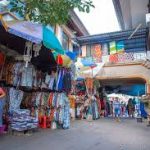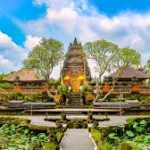Ubud is a town on the Indonesia island of Bali in Ubud District, located amongst rice paddies and steep ravines in the central foothills of the Gianyar Regency. One of Bali’s major art and culture centres, it has developed a large tourism industry.
Ubud has a population of about 30,000 people. Recently, it has become difficult to distinguish the town itself from the villages that surround it.
8th century legend tells of a Javanese priest, Rsi Markendya, who meditated at the confluence of two rivers (an auspicious site for Hindus) at the Ubud locality of Campuan. Here he founded the Gunung Lebah Temple on the valley floor, the site of which remains a pilgrim destination.
The town was originally important as a source of medicinal herbs and plants. Ubud gets its name from the Balinese word ubad (medicine). In the late nineteenth century, Ubud became the seat of feudal lords who owed their allegiance to the king of Gianyar, at one time the most powerful of Bali’s southern states. The lords were members of the satriya family of Sukawati, and were significant supporters of the village’s increasingly renowned arts scene.
Tourism on the island developed after the arrival of Walter Spies, an ethnic Germany born in Russia who taught painting and music, and dabbled in dance. Spies and foreign painters Willem Hofker and Rudolf Bonnet entertained celebrities including Charley Chaplin, Noel Coward, Barbara Hutton, H.G Wellsa and Vicki Baun. They brought in some of the greatest artists from all over Bali to teach and train the Balinese in arts, helping Ubud become the cultural centre of Bali.
A new burst of creative energy came in 1960s in the wake of Dutch painter Arie Smith (1916-), and development of the Young Artists Movement. There are many museums in Ubud, including the Museum Puri Lukisan, Museum Neka and the Agung Rai Museum Of Art.
The Bali tourist boom since the late 1960s has seen much development in the town; however, it remains a centre of artistic pursuit.



